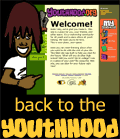
|
||
The Government Center Content AreaOverviewThe Government Center encourages youth to explore one's rights and responsibilities as a teenager, and when and how to ask for help. This content area is comprised of five units:
Click here for a complete Map of The Government Center. PurposeFor many youth, the challenges of taking charge, speaking up, and acting on their rights and responsibilities can be intimidating and confusing. Taking the time to help youth better understand the challenges of adulthood and the importance of taking responsibility for themselves can greatly increase their chances of success as they leave the high school setting. The Government Center helps youth learn about their rights and responsibilities as a teenager and as a United States citizen. The Government Center also addresses legal rights gained at the age of majority (Note: the age of majority differs from state to state, but in most states it is 18) and outlines the rights of teenagers at school, home, and work, as well as their rights within the court system. The Government Center also addresses the importance of good communication and asking for help. Teens often struggle with asking for help and it can be one of the primary reasons that they do not succeed in high school, college, or on the job. Youth with disabilities have additional material to engage with in The Government Center. This includes material to help them learn about the Individuals with Disabilities Education Act (IDEA), the impact of their disability on learning and independence, how to keep records that will document their disability, how to communicate their needs, the laws that support their rights to accommodations and services, a brief history of the Disability Rights Movement, and more. Youth OutcomesBy reading and completing online activities in The Government Center, youth will achieve the following outcomes:
See also:
Activities to AssignIn addition to the reading material available in each unit, there are numerous activities you may choose to assign youth. These include questions to consider for discussion or reflection, online and hands-on activities to complete, and other Web sites to explore. 1. Lead a DiscussionWhen working with youth in this content area, you may want to facilitate a group discussion about the topics explored in each unit. Below we’ve provided sample discussion questions to help youth explore each unit’s topic in more depth. These questions can also be used as writing assignments for youth to reflect on a topic, either confidentially in their Private Journal, or to be shared with you as their Youthhood Guide in their Class Notebook. (Note: You have the option to view and comment on their work in the Class Notebook. See Viewing & Commenting on Entries for more information.) Discussion Questions for Knowing Your Rights & Responsibilities Unit
Discussion Questions for Disability Rights Unit
Discussion Questions for Disability History Unit
Discussion Questions for Saying It Like It Is Unit
Discussion Questions for Getting Help Unit
2. Assign a "Youthhood Poll"The Youthhood homepage has a new poll question every few weeks. Youth must be logged in to vote on a poll. See About the Youthhood Poll for more information. 3. Assign "My Youthhood" ActivitiesHere at The Youthhood we’ve designed numerous online activities to help youth build a strong foundation of knowledge and to apply the material on the Web site to their own life. These include the Private Journal, Activities Folder, Life Map, and Class Notebook and are part of the "My Youthhood" menu youth see when they log in. See Online Activities for more information. Click here to Preview Online Activities in The Government Center. 4. Assign Other Web Sites to ExploreThere are some terrific Web sites available for youth to learn more about the topics covered in The Youthhood. You may wish to assign youth the task of exploring some of these Web sites. Click here to Preview Web Sites Linked in The Government Center. 5. Assign Hands-On ActivitiesIn addition to the existing materials on the site, you might create additional real-world, hands-on activities so that youth can see the concepts in action. The following are examples of hands-on activities you might assign youth in The Government Center:
Developing a Lesson PlanWe’ve provided some tips on how you might incorporate the interactive features with the content pages and your own supplemental activities to optimize learning for youth. See Developing a Lesson Plan. Web ResourcesHere are additional online resources for you as the Youthhood Guide to learn more about the topics presented within each unit of The Government Center. Titles with "(PDF)" are links to PDF documents, and require Adobe Acrobat Reader (free) to download. Knowing Your Rights and Responsibilities
Knowing Your Rights - Disability
Saying It Like It Is
Getting Help
|
||
What Can I Do Here? | Help FAQs | Curriculum Guide
Privacy | Disclaimer | About | Contact Us | Homepage
 |
 |
 |
©2006 Regents of the University of
Minnesota.
This page was updated December 5, 2018
The University of Minnesota is an equal opportunity educator and employer. Online Privacy











